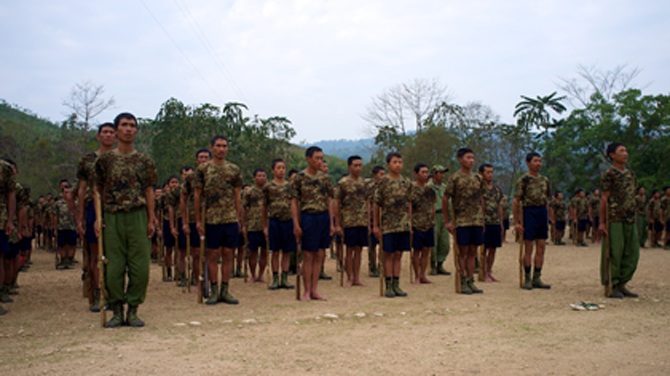Training the Next Generation of Kachin Rebels

Sumdu is nervous. In the presence of his superiors, he is asked about life in the basic training camp of the Kachin Independence Army (KIA). “All of the Kachin, the ones who live in Kachin land, need to join with the KIA to get basic freedoms,” he told The Irrawaddy.
Until two months ago he lived comfortably in northern Thailand working at a health clinic. But one day he flew to Rangoon, then Mandalay and after three days of traveling arrived in Laiza, the headquarters of the Kachin Independence Organization (KIO), on Feb. 6.
But with renewed fighting breaking out on Monday after ceasefire talks with the Burmese government broke down pmce again, the soon to be 29-year-old may be entering the fray on the Kachin frontline within a matter of weeks.
Sumdu is one of 251 recruits undergoing military instruction at the KIA's basic training camp on the outskirts of Laiza. Seventeen are women while only Sumdu and three others have worked with non-governmental organizations before and speak English.
They appear a diverse group standing to attention in the dusty square between two netless football goal posts. The flag of the KIA hangs on a high pole on this windless day—the fighting, inglorious mutilation and death merely 30 kilometers away.
After a short announcement, a low ranking officer inspects the troops and dishes out a scolding to some for improper clothing or chatting. He splits them into two groups—one departs into the forest to collect bamboo poles, the other cuts the poles to build training huts.
Most of the recruits are older than 28, the oldest is 45. The girls are 22 on average, said Lieutenant Geng Du Awng. “We don't accept soldiers under 18,” he explained. However, The Irrawaddy did meet a 17-year-old soldier on the frontlines while Human Rights Watch said in December that it had documented the use of child soldiers by the KIA.
The lieutenant himself trained at the same camp in 2004. “But now the conditions are better. We used to have to build our own accommodation in bamboo huts and were soaked when it rained,” he said.
Now just up the hill from the dusty field, a concrete building houses the soldiers. Everyone has a bunk, bamboo mat and metal box for daily rations.
In just two months they have to understand basic orders, the army's rules and regulations, military strategy and master practical battle training. During the final battle exercise in a few weeks time, they will learn how to build bridges with ropes, clear suspected hostile areas and practice one-on-one combat.
They are divided into two teams and have to simulate a battle, explains the person in charge of their training, Capt Aung Ja, sitting in the canteen hut just behind the dusty field.
His recruits have to rise at 5:30 am every morning and go through a standard routine of training units and inspections common in most armed forces. Their weekends last from Saturday afternoon to Sunday night.
On occasional evenings, a member of the central committee gives them lectures on “the politics and history of the Kachin people and Burmese history,” said Aung Ja.
As we waited for the lecture to start, Geng Du Awng points to a distant light on a hillside beyond Nabang, a part of Laiza on the Chinese side of the border. “That is our land,” he said. “The Chinese own a small wedge of land in between, and beyond that is our land.” The light comes from the KIA's officer training school.
A cheerful 34-year-old, Aung Ja sits leisurely drinking a Chinese milk drink and nibbling cookies and dried fish while two deputies relax next to him.
From 2002, he was an official with the Kachin Independence Organization, the KIA's civilian wing. But his father being a veteran, he joined the army and graduated from the officer's school in 2005—instructing recruits at the basic training camp ever since.
“I came here for the Kachin people, no one forced me to come here,” he replied when asked why he joined the army.
One journalist told The Irrawaddy that he met a female soldier complaining about being involuntarily recruited. Allegations concerning the forced recruitment of soldiers are impossible to verify here, but needless to say that most involved would prefer to live a peaceful life.
“We have to explain why we do this, have lectures in the first three weeks,” said Geng Du Awng. “Some come themselves, some are sent by village groups, some come with their parents, some don't want to stay here.”
Around half of the recruits will leave the army after the two months of training and go back to their villages to serve in militias protecting their homes, said the captain.
1 | 2 next page »
|
||
|
||
|
||
|
||
|
||
|
||
|
||
|
||
|
||
|
||
|
||
|
||
- Students Without a University
- Displaced and Distressed
- Rangoon Art Show Provides Arresting Display
- Magical Mandalay Still Holds Court for Tourists
- Distrust and Displacement on Kachin Frontline
- Thein Sein: Reformist or Caretaker?
- School’s Not Out in Kachin State
- Irrawaddy Dolphins are Firm Fisherman’s Friends
- Thein Sein: Reformist or Caretaker?
- For Rangoon Strikers, No End in Sight
